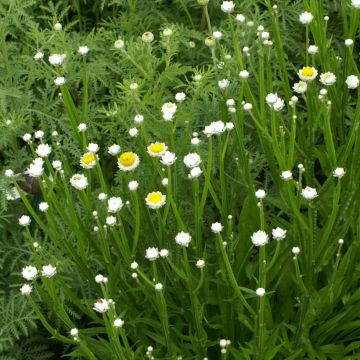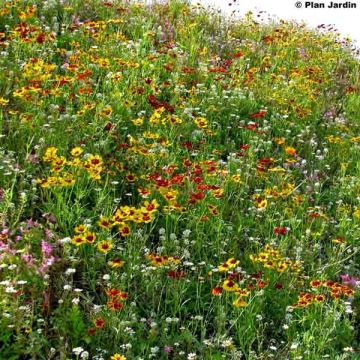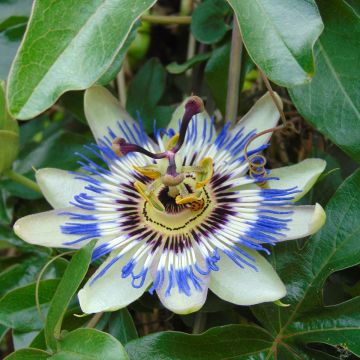

Salpiglossis sinuata Kew Blue - seeds
Salpiglossis sinuata Kew Blue - seeds
Salpiglossis sinuata Kew Blue
Painted Tongue, Scalloped Tube Tongue, Velvet Trumpet Flower
This item cannot be shipped to the selected country
Dispatch by letter from €3.90
More information
Schedule delivery date,
and select date in basket
This plant carries a 6 months recovery warranty
More information
We guarantee the quality of our plants for a full growing cycle, and will replace at our expense any plant that fails to recover under normal climatic and planting conditions.
Seed-only orders are dispatched by sealed envelope. The delivery charge for seed-only orders is €3.90.
Does this plant fit my garden?
Set up your Plantfit profile →
Description
Salpiglossis sinuata 'Kew Blue' is a very beautiful selection with dark flowers of a South American annual plant also known as Salpiglossis with changing flowers or "Velvet Trumpet". Their velvety texture catches the light, in a combination of dark blue, purple, and crimson, producing a quite stunning effect. The flowers bloom from late spring to late summer on a bushy plant. They produce seeds that can be collected and sown again in the following spring.
Salpiglossis sinuata 'Kew Blue' is a herbaceous plant of the solanaceae family, theoretically perennial but not very hardy, mostly grown as an annual. Its appearance is very similar to petunias and surfinias. Its stems are branching, flexible, and slightly trailing. It is also possible to pinch them to promote a bushy effect, the Salpiglossis will then form a clump of 50-60 cm tall and 30 cm wide in just a few months. The leaves are light green, lanceolate, and smaller towards the top of the stem. It bears several flowers, which open like funnel-shaped ones of petunias. They need sunlight to flourish. They are tubular at the base, measure 4 to 5 cm and have velvety highlights. Their dark blue colour becomes purple towards the centre, and they are traversed by dark violet veins, which highlight their small bright yellow stamens. This rich and deep colour palette is eye-catching. After being pollinated by insects, the flowers produce seeds that give rise to plants faithful to the mother plant.
Salpiglossis sinuata, somewhat forgotten by gardeners in recent years, is very decorative and undemanding. It prefers sunlight and moist but well-drained soil and will flower from June to September if you take care to remove faded flowers and possibly prune the stems in August to encourage new growth. It finds a place alongside cleomes and tall snapdragons to which it brings colour and lightness, but it also thrives in containers. Its uncommon hue may seem exotic, but it blends well in many chromatic compositions, whether pastel or more vibrant. It is a lovely companion for pink-flowered roses such as 'Bouquet Parfait' or 'Sourire de Sylvie', for example.
Report an error about the product description
Flowering
Foliage
Plant habit
Botanical data
Salpiglossis
sinuata
Kew Blue
Solanaceae
Painted Tongue, Scalloped Tube Tongue, Velvet Trumpet Flower
Cultivar or hybrid
Other Annual flower seeds
Planting and care
The 'Kew Blue' Salpiglossis should be sown under cover in a seed tray from March. If frost is still persistent in your region, wait until April, as the seeds will prefer a temperature between 18 and 25°C to germinate.
Just cover the seeds with a thin layer of compost kept slightly moist. They will germinate between 14 and 30 days. Make sure to leave the seed trays in the sun, as the seeds need it to germinate. You can also bag them to maintain a humid and warm atmosphere. When the seedlings are large enough to be moved, you can separate them and put them in pots if the frost period is not over and keep them warm (taking them out during the day) until transplanting them in the ground in May. Otherwise, you can place them in flower boxes or containers. You can gradually acclimatise them if the nights are still cool by taking them out of their shelter during the day. They prefer a substrate rich in compost, neither too dry nor waterlogged.
To further branch out the Salpiglossis, you can pinch the tips of the growing stems.
Sowing period
Intended location
This item has not been reviewed yet - be the first to leave a review about it.
Flower seeds
Haven't found what you were looking for?
Hardiness is the lowest winter temperature a plant can endure without suffering serious damage or even dying. However, hardiness is affected by location (a sheltered area, such as a patio), protection (winter cover) and soil type (hardiness is improved by well-drained soil).

Photo Sharing Terms & Conditions
In order to encourage gardeners to interact and share their experiences, Promesse de fleurs offers various media enabling content to be uploaded onto its Site - in particular via the ‘Photo sharing’ module.
The User agrees to refrain from:
- Posting any content that is illegal, prejudicial, insulting, racist, inciteful to hatred, revisionist, contrary to public decency, that infringes on privacy or on the privacy rights of third parties, in particular the publicity rights of persons and goods, intellectual property rights, or the right to privacy.
- Submitting content on behalf of a third party;
- Impersonate the identity of a third party and/or publish any personal information about a third party;
In general, the User undertakes to refrain from any unethical behaviour.
All Content (in particular text, comments, files, images, photos, videos, creative works, etc.), which may be subject to property or intellectual property rights, image or other private rights, shall remain the property of the User, subject to the limited rights granted by the terms of the licence granted by Promesse de fleurs as stated below. Users are at liberty to publish or not to publish such Content on the Site, notably via the ‘Photo Sharing’ facility, and accept that this Content shall be made public and freely accessible, notably on the Internet.
Users further acknowledge, undertake to have ,and guarantee that they hold all necessary rights and permissions to publish such material on the Site, in particular with regard to the legislation in force pertaining to any privacy, property, intellectual property, image, or contractual rights, or rights of any other nature. By publishing such Content on the Site, Users acknowledge accepting full liability as publishers of the Content within the meaning of the law, and grant Promesse de fleurs, free of charge, an inclusive, worldwide licence for the said Content for the entire duration of its publication, including all reproduction, representation, up/downloading, displaying, performing, transmission, and storage rights.
Users also grant permission for their name to be linked to the Content and accept that this link may not always be made available.
By engaging in posting material, Users consent to their Content becoming automatically accessible on the Internet, in particular on other sites and/or blogs and/or web pages of the Promesse de fleurs site, including in particular social pages and the Promesse de fleurs catalogue.
Users may secure the removal of entrusted content free of charge by issuing a simple request via our contact form.
The flowering period indicated on our website applies to countries and regions located in USDA zone 8 (France, the United Kingdom, Ireland, the Netherlands, etc.)
It will vary according to where you live:
- In zones 9 to 10 (Italy, Spain, Greece, etc.), flowering will occur about 2 to 4 weeks earlier.
- In zones 6 to 7 (Germany, Poland, Slovenia, and lower mountainous regions), flowering will be delayed by 2 to 3 weeks.
- In zone 5 (Central Europe, Scandinavia), blooming will be delayed by 3 to 5 weeks.
In temperate climates, pruning of spring-flowering shrubs (forsythia, spireas, etc.) should be done just after flowering.
Pruning of summer-flowering shrubs (Indian Lilac, Perovskia, etc.) can be done in winter or spring.
In cold regions as well as with frost-sensitive plants, avoid pruning too early when severe frosts may still occur.
The planting period indicated on our website applies to countries and regions located in USDA zone 8 (France, United Kingdom, Ireland, Netherlands).
It will vary according to where you live:
- In Mediterranean zones (Marseille, Madrid, Milan, etc.), autumn and winter are the best planting periods.
- In continental zones (Strasbourg, Munich, Vienna, etc.), delay planting by 2 to 3 weeks in spring and bring it forward by 2 to 4 weeks in autumn.
- In mountainous regions (the Alps, Pyrenees, Carpathians, etc.), it is best to plant in late spring (May-June) or late summer (August-September).
The harvesting period indicated on our website applies to countries and regions in USDA zone 8 (France, England, Ireland, the Netherlands).
In colder areas (Scandinavia, Poland, Austria...) fruit and vegetable harvests are likely to be delayed by 3-4 weeks.
In warmer areas (Italy, Spain, Greece, etc.), harvesting will probably take place earlier, depending on weather conditions.
The sowing periods indicated on our website apply to countries and regions within USDA Zone 8 (France, UK, Ireland, Netherlands).
In colder areas (Scandinavia, Poland, Austria...), delay any outdoor sowing by 3-4 weeks, or sow under glass.
In warmer climes (Italy, Spain, Greece, etc.), bring outdoor sowing forward by a few weeks.















































